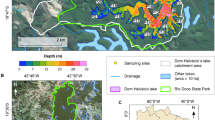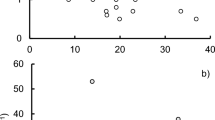Abstract
Concentrations of dissolved organic carbon (DOC) and color were measuredas a function of time in enclosures and lakes at the Experimental Lakes Area,to calculate their net loss rates. Loss rates in enclosures werefirst order for both DOC and color, with half-times for loss of 166and 122 d, respectively. Thus, the colored, light-attenuating componentof the DOC pool is lost from water more rapidly than is bulk DOC. Loss ratesin lakes, calculated from a steady state model, were similar to values forcolor in enclosures, but for DOC in lakes were four times slower than inenclosures. In lakes, loss rate for DOC increased rapidly with decreasingwater residence time (τw) but was independent ofτw when it was greater than 3 years. In lakes, theloss rate for color was independent of water residence time. Thedifference in losses of DOC and color between lakes and enclosurescould be from release of low-color DOC from sediments.
Similar content being viewed by others
References
Armstrong FAJ & Schindler DW (1971) Preliminary chemical characterization of waters in the Experimental Lakes Area, northwestern Ontario. J. Fish. Res. Board Can. 28: 171–187
Brunskill GJ & Schindler DW (1971) Geography and bathymetry of selected lake basins, Experimental Lakes Area, northwestern Ontario. J. Fish. Res. Board Can. 28: 139–155
Brunskill GJ, Povoledo D, Graham BW & Stainton MP (1971) Chemistry of surface sediments of sixteen lakes in the Experimental Lakes Area, northwestern Ontario. J. Fish. Res. Board. Can. 28: 277–294
Cooper WJ, Shao C, Lean DRS, Gordon AS & Scully FE (1994) Factors affecting the distribution of H2O2 in surface waters. In: Baker LA (Ed) Environmental Chemistry of Lakes and Reservoirs (pp 391–422). ACS Advances in Chemistry Series No. 237, American Chemical Society, Washington
Curtis PJ & Adams HE (1995) Dissolved organic matter quantity and quality from freshwater and saline lakes in eastcentral Alberta (Canada). Biogeochemistry 30: 59–76
Dillon PJ & Molot LA (in press) Dissolved organic and inorganic carbon mass balances in central Ontario lakes. Biogeochemistry: this volume
Engstrom DR (1987) Influence of vegetation and hydrology on the humus budgets of Labrador lakes. Can. J. Fish. Aquat. Sci. 44: 1306–1314
Green, SA & Blough, NV (1994) Optical absorption and fluorescence properties of chromophoric dissolved organic matter in natural waters. Limnol. Oceanogr. 39: 1903–1916
Kieber RJ, Zhou X & Mopper K (1990) Formation of carbonyl compounds from UV-induced photodegradation of humic substances in natural waters: Fate of riverine carbon in the sea. Limnol. Oceanogr. 35: 1505–1515
Meili M(1992) Sources, concentrations and characteristics of organic matter in softwater lakes and streams of the Swedish forest region. Hydrobiologia 229: 23–41
Rasmussen JB, Godbout L & Schallenberg M (1989) The humic content of lake water and its relationship to watershed and lake morphometry. Limnol. Oceanogr. 34: 1336–1343
Schindler DW (1971) A hypothesis to explain similarities and differences among lakes in the Experimental Lakes Area, northwestern Ontario. J. Fish. Res. Bd. Can. 28: 295–301
Schindler DW, Bayley SE, Curtis PJ, Parker BR, Stainton MP & Kelly CA (1992) Natural and man-caused factors affecting the abundance and cycling of dissolved organic substances in precambrian shield lakes. Hydrobiologia. 229: 1–21
Scully NM & Lean DRS (1994) The attentuation of UV radiation in temperate lakes. Arch. Hydrobiol. 43: 135–144
Tipping E, Hilton J & James B (1988) Dissolved organic matter in Cumbrian lakes and streams. Freshwater Biology 19: 371–378
Urban NR, Bayley SE & Eisenreich SJ (1989) Export of dissolved orgainc carbon and acidity from peatlands. Water Resour. Res. 25: 1619–1628
Urban NR, Gorham E, Underwood JK, Martin FB & Ogden III JG (1990) Geochemical processes controlling concentrations of Al, Fe, and Mn in Nova Scotia lakes. Limnol. Oceanogr. 35: 1516–1534
Wetzel RG (1992) Gradient-dominated ecosystems: sources and regulatory functions of dissolved organic matter in freshwater ecosystems. Hydrobiologia 229: 181–198
Author information
Authors and Affiliations
Rights and permissions
About this article
Cite this article
Curtis, P.J., Schindler, D.W. Hydrologic control of dissolved organic matter in low-order Precambrian Shield lakes. Biogeochemistry 36, 125–138 (1997). https://doi.org/10.1023/A:1005787913638
Issue Date:
DOI: https://doi.org/10.1023/A:1005787913638




